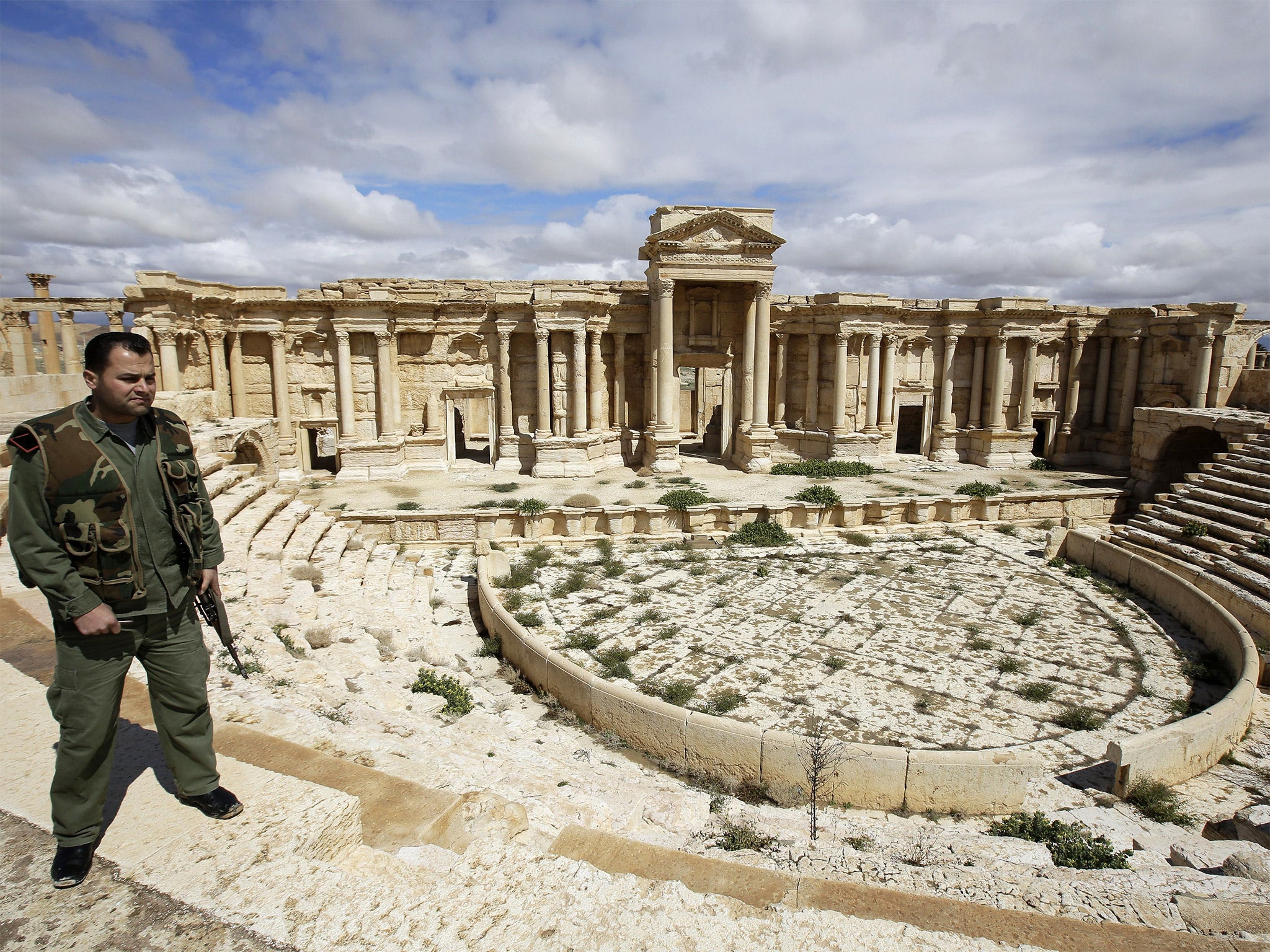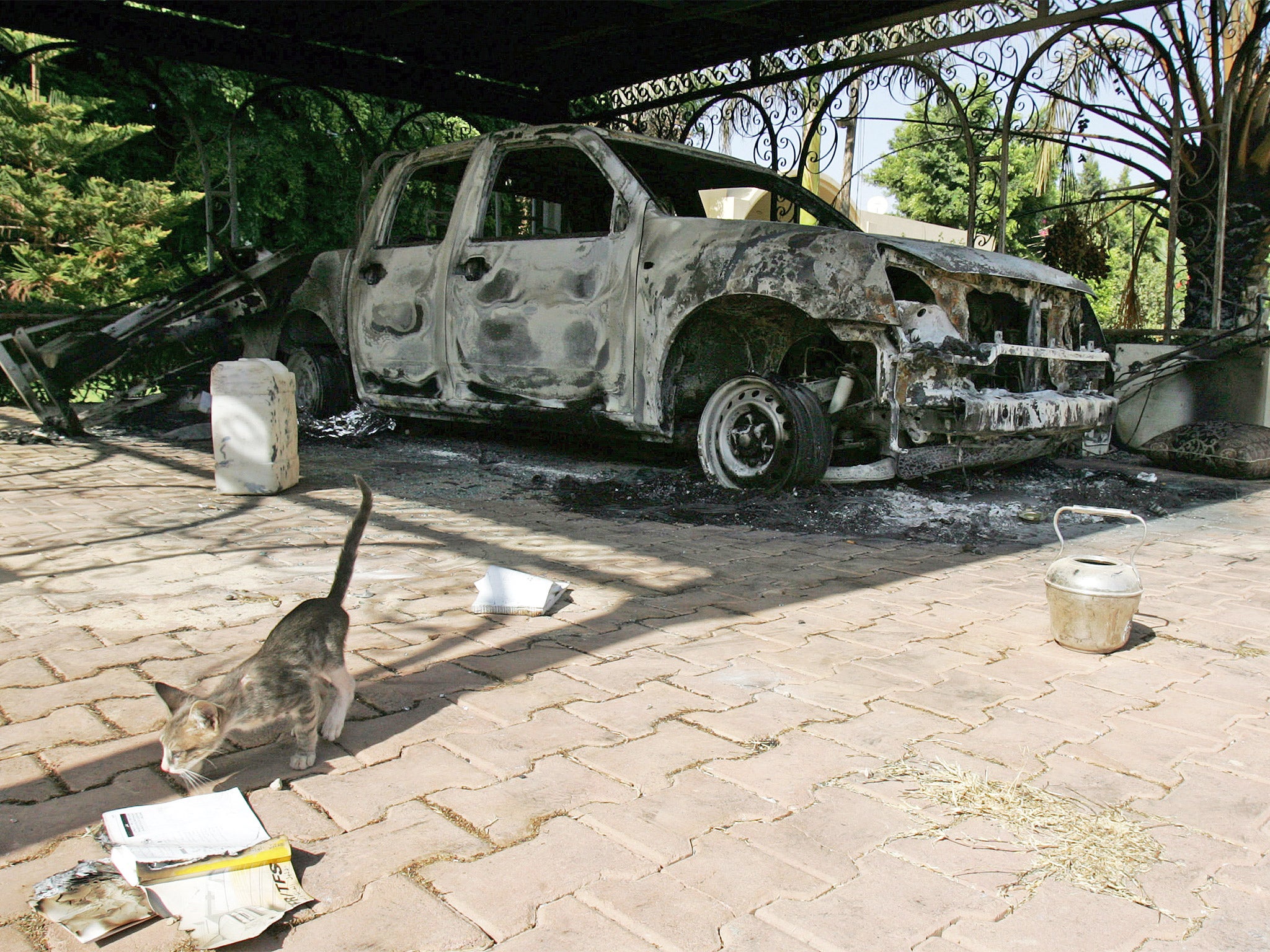Isis in Syria: Militants carry out threat to destroy Unesco-protected historical sites as they are forced to retreat from Palmyra
Destruction seen as message to President Bashar al-Assad's forces that the rest of the site will be destroyed if the Syrian army advances are not checked

Isis has begun carrying out its threat to destroy structures in the ancient Syrian city of Palmyra, blowing up at least two monuments at the Unesco-protected site as Syrian government troops made advances on the Islamist’s positions.
Photographs published by the group showed the bombing of a tomb about 2.5 miles north of the centre of Palmyra, and of another shrine, which lies just outside the main Unesco site.
It is believed that mines have been planted around other, better-known monuments, including the Roman-era amphitheatre above which Isis’s black flag has been raised, ready for detonation at any time.
Fears were raised for the ancient site, parts of which date back 4,000 years, after Isis captured it last month, following its destruction of other ancient sites and monuments across Iraq and Syria.
Dedicated to a radical interpretation of Islam, Isis believes that nothing should pre-date the birth of the Prophet Mohammed, which according to the Gregorian calendar widely used in the West, is around 570 AD. “They consider these Islamic mausoleums to be against their beliefs, and they ban all visits to these sites,” Syria’s antiquities director Maamoun Abulkarim said. The threat to sites in Palmyra came as Syrian government forces made advances on the town.
It seems likely that the destruction was sent as a sign to President Bashar al-Assad’s forces that the rest of the site will be destroyed if the Syrian army advances are not checked. Some reports had Syrian forces just five miles from the Isis front-line position in the village of Al-Amariyah.
“It is not known if the purpose is to blow up the ruins or to prevent regime forces from advancing into the town,” Rami Abdel Rahman, the director the Britain-based Syrian Observatory for Human Rights told the Al-Jazeera network. “It seems clear that the Syrian regime has increased its air strikes and wants to push [Isis] out.”
The destruction at Palmyra came as it emerged that one of Isis’s leading figures, the Tunisian, Ali Awni al-Harzi, has been killed in a US air strike in the Isis stronghold of Mosul in Iraq. As well as being a leading Isis militant, al-Harzi was identified by the US as being a key architect of the attack on the US compound in the Libyan city of Benghazi on 11 September 2012 when Washington’s envoy, Christopher Stevens, was killed.
Al-Harzi “operated closely with multiple [Isis]-associated extremists throughout North Africa and the Middle East”, US Defence Department spokesman, Colonel Steve Warren said in a statement. “His death degrades [Isis’s] ability to integrate North African jihadists into the Syrian and Iraqi fight and removes a jihadist with long ties to international terrorism.”

A leading fixer for the Islamist cause, al-Harzi had reportedly been in charge of Isis’s recruitment of foreign fighters. Only added to US’s target list in April this year, he first came to prominence as a member of the al-Qaeda-linked Tunisian outfit, Ansar al-Sharia, in 2011. After the Benghazi attacks a year later, it is believed he moved to Syria and joined-up with Jabhat al-Nusra, the other main Islamist group fighting the Assad government, before joining Isis. It is likely that he was killed last week.
The US-led coalition relies on intelligence for its bombing targets and three groups of young men, accused by Isis of being spies, were murdered by the group, with the killings filmed and uploaded on to the internet.
The three groups are shown in a professionally edited video similar to those produced to show the apparent beheadings of British and American hostages last year, which featured the militant known ubiquitously as Jihadi John. The first group is shown being shut in a car which is then blown up using and a rocket propelled grenade. The second is a shown being locked in a cage similar to that used in the murder in January of Jordanian fighter pilot, Moaz al-Kasasbeh. In the film, five men are placed in the cage before it is winched into what appears to be a swimming pool. Small cameras are attached to the side of the cage and show the men drowning.
The third group is shown kneeling in line as explosives are attached to the captives’ necks. The bombs are detonated remotely, killing the men instantly.
The fight against Isis: Kurds close to Raqqa
Kurdish militias fighting Isis in Syria have advanced to within 30 miles of the jihadists’ capital, Raqqa, capturing the town of Ain Issa and a key military base nearby.
The gain of Ain Issa is significant. It suggests that air strikes against Isis targets in Syria and Iraq are weakening the group – as is fighting on the ground, where Isis faces the disciplined Kurdish fighters from the People’s Protection Units, or YPG.
It also comes after another town, Tal Abyad, fell to the Kurds last week, helping to sever a supply line to Raqqa.
Ain Issa and the villages that surround it are the last major settlements to the north of Raqqa before the city itself is reached. As a result, Rami Abdul Rahman, the Syrian Observatory for Human Rights’ director, told AFP: “[Isis’s] defensive lines have now been pushed back to the outskirts of Raqqa city, because the area between Raqqa and Ain Issa is militarily weak and they have no fortifications.”
Alistair Dawber
Join our commenting forum
Join thought-provoking conversations, follow other Independent readers and see their replies
Comments